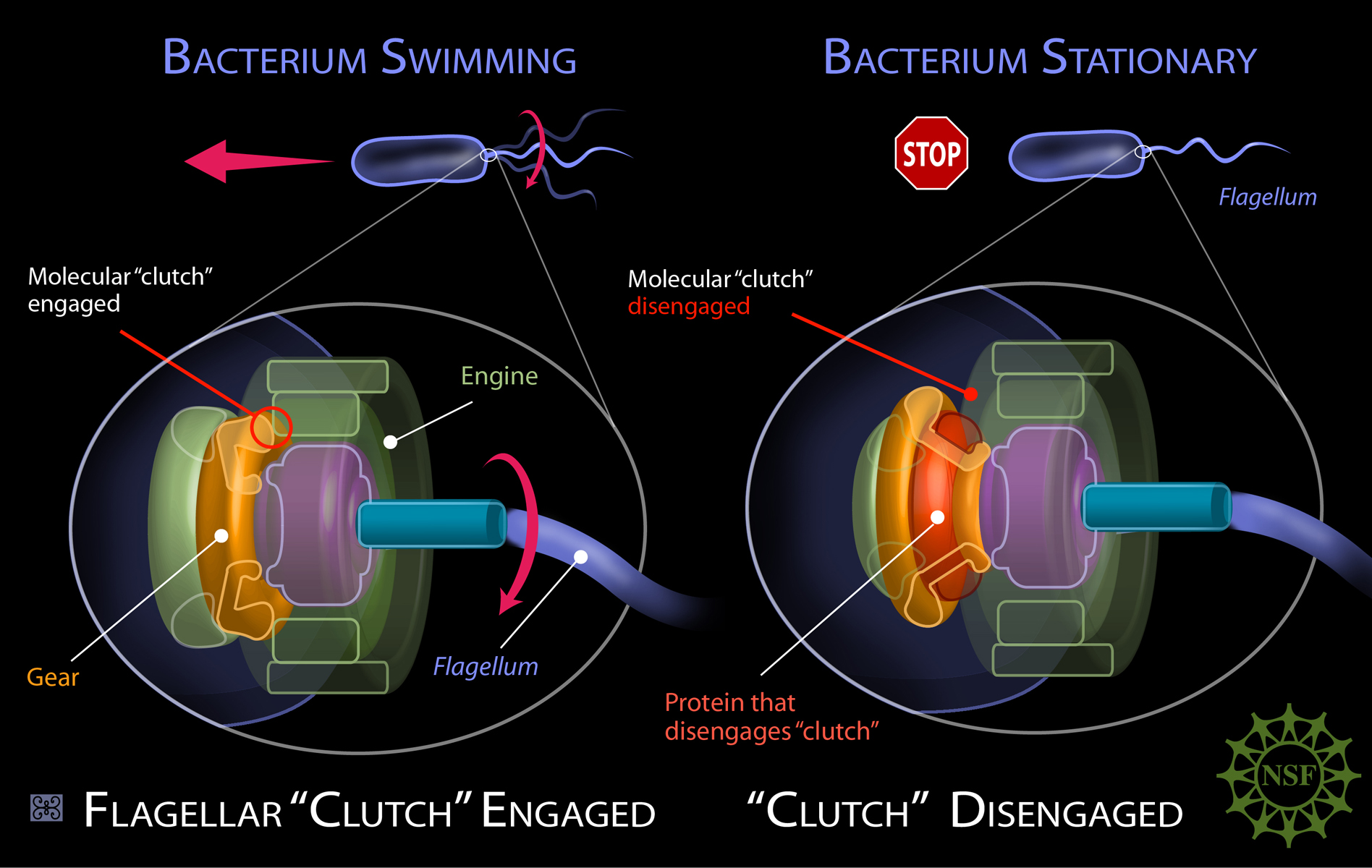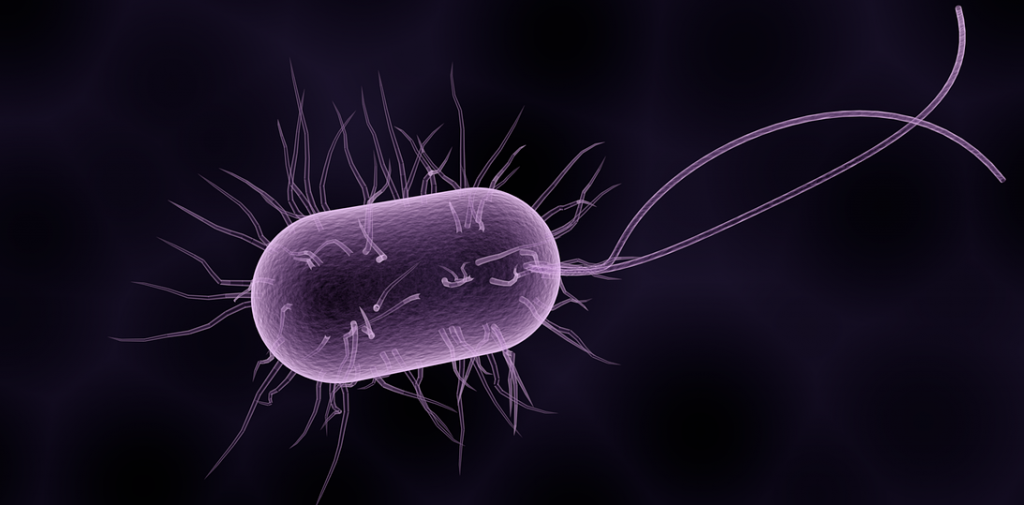The First Motor! Proof of God Maybe?
By proof of God I mean the sheer weight of circumstantial evidence that can be deduced from creation.
The picture above shows one of the most impressive motors in terms of structure and performance the world has ever known. And yet it looks primitive and simple. A sausage shaped body with a couple of long tails moving through a liquid environment at a rate of body lengths per minute as yet to be equalled by anything produced through modern technology. How deceptive an appearance of simplicity can be: in this case a microbe: a bacteria. It was of course as evolutionary theory demands incredibly simple and came into being roughly 3.5 billion years ago. Without this as yet unsubstantiated assumption Darwinism collapses, but for now we must accept it as the only alternative to a designer. But as nature abhors a vacuum and modern science abhors a god lets stick to the script, lay aside our commonsense and take a look at the first motors to appear on earth.
Bacteria have the three types of motor illustrated in the video below. We start with the flagellar motor of Escherichia coli: a common form of bacteria.
ATP synthase is a molecular complex which supplies the energy needs of all life. It captures chemical energy obtained from the breakdown of food molecules and releases it to fuel other cellular processes. It had to be in existence prior to the first life because there is an initial problem that life has to overcome. No source of energy, no life.
I am a child in matters of science so perhaps you could answer this childlike question. If the above motors are accurately described, and were intrinsic to the wellbeing of the most primitive living organisms which arose from the primeval slime of the early Earth, then how come that modern science cannot get close to replicating their advanced nanotechnology? And believe me science has been trying for quite some while. If you watch the video at the bottom of this article you will hear a scientist who passionately looks forward to that day when we catch up and utilise a technology we know works. If it didn’t work we would not know because we would not yet exist. Because we along with microbes share the internal technology essential for life. In fact we share the microbes as well, no microbes no you or I. It is amazing when we come to realise the co-ordination required for any of this to happen. In bacteria you have Dna, a membrane which fulfils many functions and without doubt the finest engine on planet Earth. And this brief inventory misses out many things far too complex for me to follow or understand.
After about two billion years of evolution, if you believe it, which I do not; the kind of cells emerged which led to mammal and finally human life. After a further billion or two years a kind of ape supposedly evolved into the tool making species Homo Sapiens, examples of our early efforts shown below.


Its a good start but it contrasts starkly with bacterial life. Humans have intelligence and over time have evolved, ( the correct word in this context ), incredible technologies. But here is a conundrum; bacteria, which are without intelligence had vastly superior technology to us from the first spark of life. Why are they so gifted? Why does one species have to work for its advancement while the other unconsciously bathes in its superior technological status. Maybe the creator of both saw something we have missed. Perhaps we were intended to develop by thought processes and ambition, and then to seek out the meaning of life. To look at the stars in wonder and pursue that wonder through the scientific method. It should be acknowledged that science was largely birthed in this kind of questioning environment. The pioneers of the scientific method in the West were mostly bible believing Christians. They had a template into which they could pursue ideas because they believed the earth and the cosmos had a rational genesis. Born in a creative and rational mind vastly superior to our own. Hence it is unsurprising that men of this mindset, who expected rationality to govern creation discovered the laws that underpin both physics and chemistry. They found that mathematical equations of beautiful simplicity and ingenuity ruled over all things physical, from the atomic domain upwards. The quantum world of atomic particles is admittedly a strange exception. The fact that these discoveries have been made is perhaps a hint to us that we really are fearfully and wonderfully made by a Creator or a Designer, and that we are meant to know and understand just how special we are.
The crude denial of that possibility explains the mindset of those who choose for themselves the evolutionary microbe to ape to human route. Self abnegation of a religious type perhaps, chosen in order to escape the horror of being a Creator’s creation. And even worse responsible for our actions before a maker and teacher who both cares for and loves us, and who in addition desires and expects us to search for the one who put it all into existence.
So, after that small diversion let’s continue by underlining the disparity between our first efforts at tools, weapons, ornaments etc and those of nature by examining the graphic below. The engines of bacteria are complex, having both gears and clutches.

The story so far. Nature in its most primitive state sponsors the arrival of microscopic creatures. These exist without a brain to initiate an idea or a sense of purpose. And yet they exist with ease, search for and find food and replicate on cue without a thought about how or why. They would in our world define the word ignoramus: the ultimate dunces. They flourish without a thought and obey whatever it is that prompts them. Whether they live or die is an irrelevance, and yet they seem to do everything they are capable of doing as if they cared. They somehow create out of whatever scraps of material were available to them motorised machines of astounding utility. Their engines are so sophisticated they have, as shown above, gears and clutches. This is creature operating a nano machine a millionth the size of a grain of sand that can rotate five times faster than a Formula One engine (18,000 rpm ) and can change direction faster than a mosquito beats it wings. A vibrio bacteria can stop and reverse its top speed 100,000 revs per minute engine in a quarter turn and then continue at it top speed in another direction. That is some special kind of clutch and gearing system. The motors in the bacterium speak of design while their lack of nervous system set them up as a brain dead unit. What we have is a strange twinset: a supremely fine tuned engine and a mindless host. But if that were the case how would they navigate towards their food supplies. These contradictions are not natural bedfellows. This is supposed to be simple stuff. Who or what gave the dumb bacteria its extraordinary motors and the capacity to live an active and meaningful life. If the organism itself has little to no clue, or self-awareness, or method of equipping itself then how did it get its hardware: the rotary motor, and software: DNA? By chance?
We can look at ourselves and ask these and many other questions, but most of us it seems choose to avoid them. Such questions are for philosophers and theologians, not your average Joe. But why not let the fool dream his dreams and search the dark areas while seeking that single immutable beauty: the truth. Questions do arise. Why should the lowest life forms on earth with an IQ of absolute zero be equipped with the finest possible motility systems? The only answer I can think of is that they have them because they need them. Who meets the need once the need is realised? The lesser usually looks to the greater for answers. But even that is ruled out, the bacteria spawned by evolutionary processes is not looking for a motor. And the motor cannot have come first because it is embedded in a membrane. It does not know it needs one and even if it did it would have to wait for beneficial mutations in perfect sequence and beyond counting before it could even hope. But even hope is not an option because there is no sense of direction or purpose permitted in evolutionary scenarios. So who or what supplied the needs? It must have been far thinking even at the microbial level to have anticipated all the roles that microbes are required to fill. Please read any scholarly article on this subject, there are many available on the internet. Microbes are vital to all life, they support everything you can think of from the Eco-system onwards. They are ubiquitous throughout nature. Without them there would be no life nor you and I.
So who or what did it?



